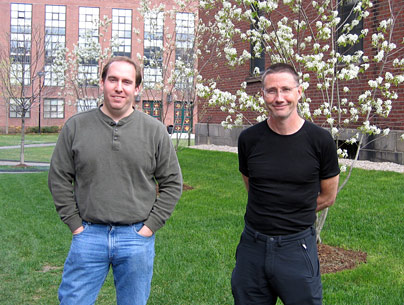Authors Ben Allen (left) and Andy McMahon
Hedgehog (Hh) proteins are secreted morphogens that act in a concentration depependent manner to shape numerous developmental processes. The effects of Hh signaling have been best studied in the developing neural tube, where sonic hedgehog (Shh) signaling serves to specify all ventral cell identities. A critical aspect of Shh signaling is that relatively small (~2-fold) changes in the concentration of ligand result in the specification of distinct cell fates. As such, a major question in the field of Hh biology is how the developing embryo precisely regulates the levels of Shh to ensure proper development.
In the May 15th issue of Genes & Development, Allen et al., demonstrate a novel role for the cell surface protein growth arrest specific 1 (Gas1) in the promotion of Shh signaling in multiple tissues during mouse embryogenesis. Specifically, genetic studies indicate that Gas1, a GPI-linked cell surface protein that binds Shh with high affinity, promotes Shh signaling during craniofacial and skeletal development, digit specification and neural tube patterning. Additionally, chick neural tube electroporation experiments directly demonstrate that Gas1 acts at the level of ligand to promote the Shh-dependent specification of ventral cell fates. Many of these finding are corroborated by a concurrent report in the same issue by Martinelli and Fan. Allen et al. further demonstrate that Gas1 cooperates with Cdo, a second, structurally unrelated, cell-surface Hh-binding protein to promote Shh signaling in a tissue-specific manner.
This study represents an important step forward in our understanding of the regulation of Hh signaling, yet a number of questions remain unanswered. These questions include identifying more precisely the molecular mechanisms by which Gas1 and Cdo, as well as other Hh-binding proteins regulate the trafficking, turnover, and activity of Shh ligand that is necessary to achieve the correct levels of signaling during embryogenesis.


